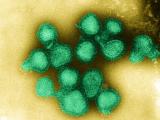Aug 24, 2011
Report details likely instances of presymptomatic H1N1 transmission
Epidemiologic investigation indicated three clusters of patients in Osaka, Japan, early in the 2009 H1N1 pandemic where H1N1 transmission may have occurred before patients became symptomatic, according to a study today in Emerging Infectious Diseases (EID). Investigators identified 36 pandemic H1N1 cases in Osaka Prefecture from May 17 to 22, 2009, that were confirmed by polymerase chain reaction. They followed up with all patients plus their contacts by phone, in person, or both. Their trace-back steps identified three instances of likely transmission before patients were symptomatic, all in schoolchildren. The first two clusters involved high school students from the same school. In the first, one student was likely infected in school; in the second, three students became sick after spending several hours playing video games together. The third cluster involved two students who sat together during a 3-hour train ride when both exhibited no flu symptoms. The authors conclude, "This finding has public health implications because it indicates that viral transmission in communities cannot be prevented solely by isolating symptomatic case-patients."
Aug 24 EID report
Study: Peds hospitals underequipped to handle flu pandemics
A study of occupancy rates at 34 US children's hospitals during the fall wave of the 2009 H1N1 pandemic found that a more virulent flu strain would have easily overwhelmed their capacity, according to an EID study today. Researchers explored inpatient and emergency department data during 11 weeks in which the percentage of samples testing positive for influenza exceeded 20%. For comparison they looked at data from Jan 31 through Mar 20 of the 2008-09 flu season, when flu also exceeded the 20% threshold. The group built five models to test what would have happened with different ED visit and hospital admission rates. They found that the hospital occupancy rate was 95% during the fall pandemic wave, which was lower than the 2008-09 period. However, projections revealed that as little as 1 additional admission per 10 inpatient beds would have pushed occupancy to 100%. Modeling showed that a more virulent pattern could have pushed occupancy to as high as 132% of capacity. Marion Sills, MD, MPH, the study's lead author and associate pediatrics professor at the University of Colorado, said in a press release that children's hospitals have little reserve for even a modest surge. "H1NI was not as virulent as people had feared, but the next one might be," Sills said. "It wouldn't take a much more virulent virus to get us into serious trouble," she said.
Aug 24 EID study
Aug 23 EurekAlert press release
Study shows Mexican students at high risk, health workers at low risk of H1N1
Mexican researchers found through serology studies that more than half of K-12 students in that country contracted pandemic 2009 H1N1 flu, compared with 33% of the general population and only one quarter of healthcare workers. They divided 2,222 subjects into one of five categories: students, teachers, healthcare workers, nursing home residents aged 60 years or older, and the general population. Seroprevalence was 47.3% for all students, 33.9% for teachers, 24.6% for healthcare workers, 36.5% for older adults, and 33.0% for the general population. The breakdown among students was 52.7% for elementary, 56.6% for middle school, 56.4% for high school, and 31.1% for college. Among teachers the trend was quite different: Seroprevalence was 44.6% for college, 31.6% for middle school, 29.8% for elementary, and 20.3% for high school. The authors write, "Students represent a key target for preventive measures."
Aug 22 Int J Infect Dis abstract
NIOSH study: N-95s lose fit after multiple donnings
N-95 filtering facepiece respirators (FFRs) appear to lose their fit after multiple successive donnings, according to a research team led by National Institute for Occupational Safety and Health (NIOSH) scientists. They studied six NIOSH-certified N-95 FFRs using 10 experienced wearers per respirator. The FFRs were tested for fit after each of up to 20 N-95 donnings, and the scientists then performed regression analyses for the percentage of donnings that scored a fit factor (FF) of 100 or higher, which was considered a passing grade. Donnings with a passing grade ranged from 81% to 93% for 1 to 5 donnings, 71% to 86% for 6 to 10 donnings, 62% to 83% for 11 to 15 donnings, and 53% to 75% for 16 to 20 donnings. The team also found that some models held up better during reuse. They summarize, "The data suggest that 5 consecutive donnings can be performed before FFs consistently drop below 100." However, they underscore that this number does not constitute a recommendation, saying, "Further research is needed to better understand the limitations of FFR reuse, especially in actual workplace settings."
Aug 24 Am J Infect Control abstract



















